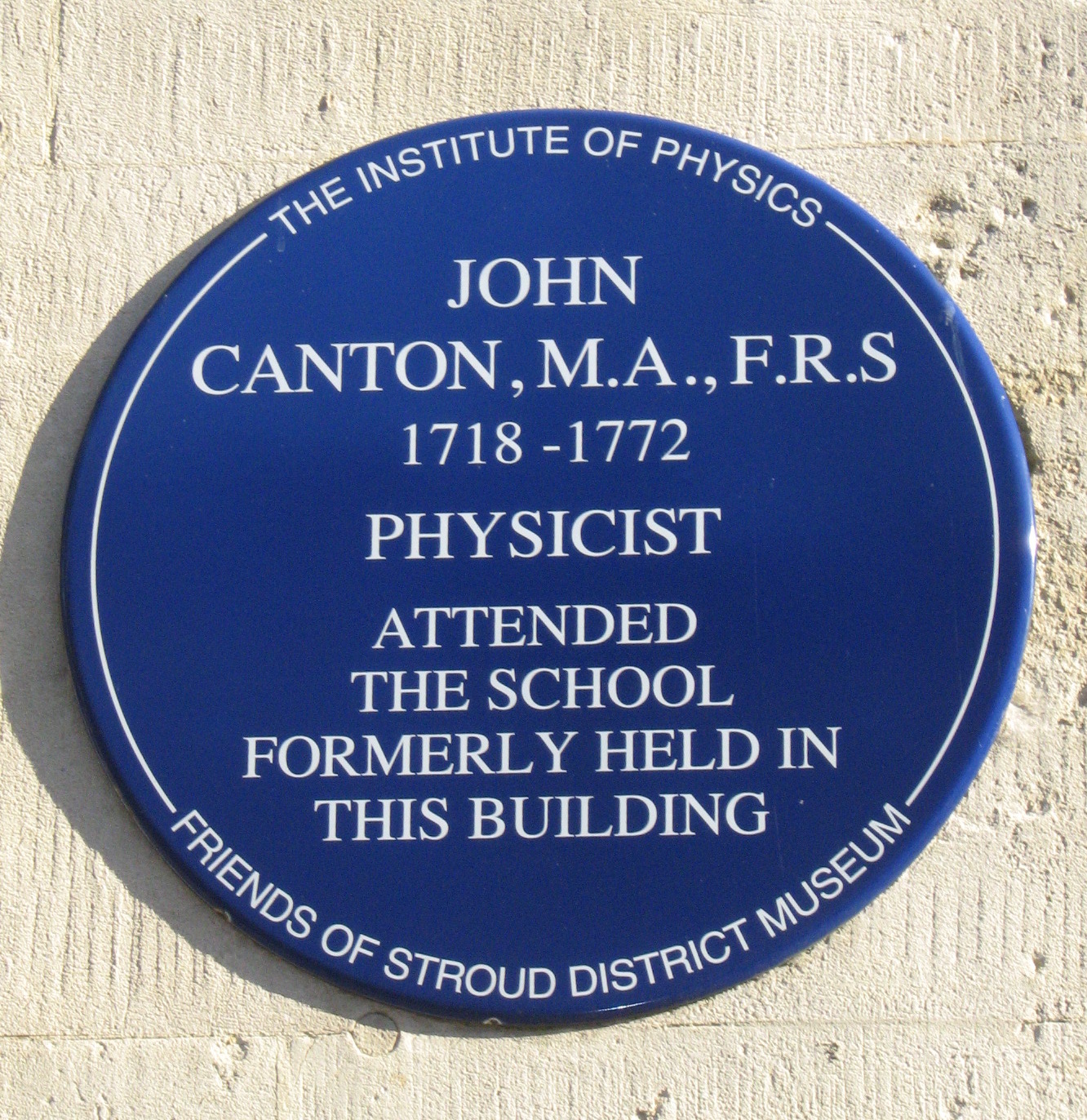John Canton on:
[Wikipedia]
[Google]
[Amazon]
John Canton FRS (31 July 1718 – 22 March 1772) was a  In 1750 he read a paper before the Royal Society on a method of making artificial
In 1750 he read a paper before the Royal Society on a method of making artificial
Canton's phosphorus
His investigations were carried on whilst he worked as a school teacher. He died in London aged 53 of
British
British may refer to:
Peoples, culture, and language
* British people, nationals or natives of the United Kingdom, British Overseas Territories, and Crown Dependencies.
** Britishness, the British identity and common culture
* British English, ...
physicist
A physicist is a scientist who specializes in the field of physics, which encompasses the interactions of matter and energy at all length and time scales in the physical universe.
Physicists generally are interested in the root or ultimate cau ...
. He was born in Middle Street Stroud, Gloucestershire, to a weaver, John Canton (b. 1687) and Esther (née Davis). As a schoolboy, he became the first person to determine the latitude
In geography, latitude is a coordinate that specifies the north– south position of a point on the surface of the Earth or another celestial body. Latitude is given as an angle that ranges from –90° at the south pole to 90° at the north pol ...
of Stroud, whilst making a sundial. The sundial caught the attention of many, including Dr Henry Miles
Henry Miles, FRS (2 Jun 1698 – 10 Feb 1763) was an English Dissenting minister and scientific writer; a Fellow of the Royal Society known for experiments on electricity.
Life
He was born at Stroud, Gloucestershire, on 2 June 1698. He was educat ...
, a Stroud-born Fellow of the Royal Society. Miles encouraged Canton to leave Gloucestershire to become a trainee teacher for Samuel Watkins, the headmaster of a Nonconformist school in Spital Square, London, with whom he ultimately entered into partnership.
 In 1750 he read a paper before the Royal Society on a method of making artificial
In 1750 he read a paper before the Royal Society on a method of making artificial magnet
A magnet is a material or object that produces a magnetic field. This magnetic field is invisible but is responsible for the most notable property of a magnet: a force that pulls on other ferromagnetic materials, such as iron, steel, nicke ...
s, and was subsequently elected a Fellow of the society (FRS). In 1751 he was a recipient of the Copley Medal "On account of his communicating to the Society, and exhibiting before them, his curious method of making Artificial Magnets without the use of Natural ones." He was the first in England to verify Benjamin Franklin's hypothesis of the identity of lightning and electricity
Electricity is the set of physical phenomena associated with the presence and motion of matter that has a property of electric charge. Electricity is related to magnetism, both being part of the phenomenon of electromagnetism, as describ ...
, and he made several important electrical discoveries.
In 1762 and 1764 he published experiments in refutation of the decision of the Florentine Academy, at that time generally accepted, that water
Water (chemical formula ) is an Inorganic compound, inorganic, transparent, tasteless, odorless, and Color of water, nearly colorless chemical substance, which is the main constituent of Earth's hydrosphere and the fluids of all known living ...
is incompressible. In 1768 he described the preparation, by calcining oyster-shell with sulphur, of the phosphorescent
Phosphorescence is a type of photoluminescence related to fluorescence. When exposed to light (radiation) of a shorter wavelength, a phosphorescent substance will glow, absorbing the light and reemitting it at a longer wavelength. Unlike fluor ...
material known aCanton's phosphorus
His investigations were carried on whilst he worked as a school teacher. He died in London aged 53 of
dropsy
Edema, also spelled oedema, and also known as fluid retention, dropsy, hydropsy and swelling, is the build-up of fluid in the body's tissue. Most commonly, the legs or arms are affected. Symptoms may include skin which feels tight, the area ma ...
.
He was the recipient of letters that formed the foundation for modern day Bayes' Theorem from Thomas Bayes
Thomas Bayes ( ; 1701 7 April 1761) was an English statistician, philosopher and Presbyterian minister who is known for formulating a specific case of the theorem that bears his name: Bayes' theorem. Bayes never published what would become his ...
, which were then published by the Royal Society. John Canton did not receive those letter directly from Bayes, but through an intermediary after the death of Thomas Bayes. Richard Price
Richard Price (23 February 1723 – 19 April 1791) was a British moral philosopher, Nonconformist minister and mathematician. He was also a political reformer, pamphleteer, active in radical, republican, and liberal causes such as the French ...
initially established the communication between Thomas Bayes and John Canton.
Canton is now mainly remembered for his work in electrostatics, particularly the invention of the pith ball electroscope, and his studies in atmospheric electricity
Atmospheric electricity is the study of electrical charges in the Earth's atmosphere (or that of another planet). The movement of charge between the Earth's surface, the atmosphere, and the ionosphere is known as the global atmospheric electr ...
. He is honoured with a blue plaque at the site of his old school in his hometown of Stroud.
References
External links
* * * {{DEFAULTSORT:Canton, John 1718 births 1772 deaths English physicists Fellows of the Royal Society Recipients of the Copley Medal People from Stroud Deaths from edema 18th-century English people Enlightenment scientists